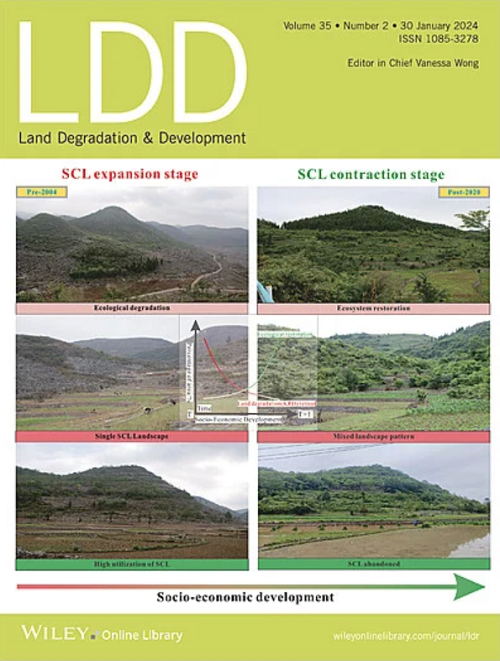Investigating the Mechanisms Impacting Soil Ca, Mg, and Na in Wastewater Land Application Systems Using Machine Learning Models
IF 3.6
2区 农林科学
Q2 ENVIRONMENTAL SCIENCES
引用次数: 0
Abstract
Wastewater land application is a widely accepted solution for addressing global water crisis, particularly in arid and semiarid regions, but it may cause soil Ca, Mg, and Na accumulation and result in soil degradation. The objective of this study was to investigate the underlying mechanisms impacting soil Ca, Mg, and Na in wastewater land application systems using tree-based machine learning models. Using data collected from previous field studies, decision tree (DT), random forest (RF), and extreme gradient boosting decision trees (XGBoost) models were developed to predict soil Ca, Mg, and Na in wastewater land application systems. XGBoost models showed the best performance, with R2 and RMSE values of 0.999 and 18.9 mg/kg, 0.999 and 3.2 mg/kg, and 0.912 and 104 mg/kg on the training data and 0.989 and 345 mg/kg, 0.925 and 56.1 mg/kg, and 0.908 and 112 mg/kg on the test data for soil Ca, Mg, and Na prediction, respectively. Permutation importance analysis reveals that initial soil Ca and electrical conductivity (EC) and total irrigation amount, initial soil Mg, total precipitation and initial soil EC, and initial soil Na, total irrigation amount and wastewater Na were the top three predictive variables for soil Ca, Mg, and Na, respectively. Partial dependence analysis demonstrates how soil Ca, Mg, and Na changed with the predictive variables, and indicates that wastewater irrigation caused soil Ca, Mg, and Na accumulation. This study highlights the need for sustainable wastewater land application management to control soil sodium adsorption ratio and mitigate the risks of land degradation.利用机器学习模型研究废水土地应用系统中土壤钙、镁和钠的影响机制
废水的土地应用是解决全球水危机(尤其是在干旱和半干旱地区)的一种广为接受的解决方案,但它可能会导致土壤中 Ca、Mg 和 Na 的积累,造成土壤退化。本研究的目的是利用基于树的机器学习模型,研究影响废水土地应用系统中土壤钙、镁和钠的潜在机制。利用从以前的实地研究中收集的数据,开发了决策树(DT)、随机森林(RF)和极端梯度提升决策树(XGBoost)模型来预测废水土地应用系统中的土壤钙、镁和钠。XGBoost 模型表现最佳,在土壤钙、镁和钠的预测方面,训练数据的 R2 和 RMSE 值分别为 0.999 和 18.9 mg/kg、0.999 和 3.2 mg/kg 以及 0.912 和 104 mg/kg,测试数据的 R2 和 RMSE 值分别为 0.989 和 345 mg/kg、0.925 和 56.1 mg/kg 以及 0.908 和 112 mg/kg。置换重要度分析表明,初始土壤 Ca、导电率(EC)和总灌溉量,初始土壤 Mg、总降水量和初始土壤 EC,初始土壤 Na、总灌溉量和废水 Na 分别是土壤 Ca、Mg 和 Na 的前三个预测变量。部分依存分析表明了土壤钙、镁和钠随预测变量的变化情况,并表明废水灌溉导致了土壤钙、镁和钠的积累。这项研究强调了可持续的污水土地应用管理的必要性,以控制土壤钠吸附率,减轻土地退化的风险。
本文章由计算机程序翻译,如有差异,请以英文原文为准。
求助全文
约1分钟内获得全文
求助全文
来源期刊

Land Degradation & Development
农林科学-环境科学
CiteScore
7.70
自引率
8.50%
发文量
379
审稿时长
5.5 months
期刊介绍:
Land Degradation & Development is an international journal which seeks to promote rational study of the recognition, monitoring, control and rehabilitation of degradation in terrestrial environments. The journal focuses on:
- what land degradation is;
- what causes land degradation;
- the impacts of land degradation
- the scale of land degradation;
- the history, current status or future trends of land degradation;
- avoidance, mitigation and control of land degradation;
- remedial actions to rehabilitate or restore degraded land;
- sustainable land management.
 求助内容:
求助内容: 应助结果提醒方式:
应助结果提醒方式:


